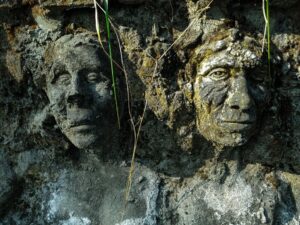The Enigmatic and Fatal Kuru Disease Explored

Kuru, a neurodegenerative disease, once terrorized the Fore people of Papua New Guinea. Characterized by headaches, tremors, and loss of coordination, it led to severe muscle spasms, emotional outbursts, and eventually paralysis and death. This disease, emerging in the early 1900s, mystified researchers for decades.
During the Australian occupation of New Guinea in 1914, colonial officials began to notice the disease among the Fore and neighboring tribes. Early observers, like Arthur Carey and John McArthur, attributed Kuru to psychosomatic factors, influenced by local beliefs in sorcery.
American virologist Daniel Gajdusek and physician Vincent Zigas, rejecting the psychological explanation, initiated the first comprehensive study of Kuru. Their initial hypothesis suggested a genetic link, but this required further investigation into the Fore’s kinship practices.
In 1961, researchers Michael Alpers and Shirley Lindenbaum, funded by the Rockefeller Foundation, conducted an extensive study among the Fore. They discovered that Kuru was not genetically transmitted but spread through a social practice: mortuary cannibalism, prevalent among the Fore.
The Fore’s ritual of consuming deceased family members, particularly the brain, was pivotal in spreading Kuru. Women and children were primarily affected due to their roles in these rituals. This practice explained the higher prevalence of Kuru among these groups.
In 1968, brain samples from a Kuru victim were used in an experiment by Gajdusek and his team, injecting them into chimpanzees. The animals developed symptoms similar to Kuru, confirming its transmissibility and suggesting a novel pathogen.
Gajdusek’s groundbreaking work earned him the Nobel Prize in Physiology and Medicine in 1976. However, the causative agent of Kuru remained unidentified until the late 1970s, when similarities with scrapie and Creutzfeldt-Jakob disease led to the discovery of prions – misfolded proteins causing these fatal neurodegenerative diseases.
Exploring the Tanganyika Laughing Epidemic of 1962
The Tanganyika Laughing Epidemic, which affected over 1,000 people and led to the temporary closure of four schools, serves as a compelling case study in mass hysteria. This topic would delve into how psychological and environmental stressors can trigger such widespread and unusual symptoms, analyzing the unique conditions that led to this bizarre outbreak.
The history of Kuru, a prion disease linked to cannibalistic rituals, sheds light on the intersection of culture, disease transmission, and neurodegeneration. This topic would explore how Kuru impacted humans, causing brain tissue degeneration and severe neurological symptoms, and its eventual contribution to the understanding of prion diseases.
Understanding Pseudobulbar Affect (PBA)
Pseudobulbar affect (PBA), a condition characterized by uncontrollable laughing or crying, often in inappropriate situations, is an important neurological disorder to consider. This topic would explore the causes, symptoms, and effects of PBA, examining how it relates to other neurological conditions and impacts emotional regulation in the brain.
Key Statistics About Kuru Disease
Kuru, a rare neurodegenerative disorder, claimed approximately 2,700 lives by 2005. This statistic underscores the significant impact the disease had on the Fore people in Papua New Guinea before measures were taken to halt its spread.
The Kuru epidemic witnessed a notable decline over time. Initially, in 1957, there were about 200 deaths per year. However, this number drastically reduced, with no reported deaths from the disease since at least 2010. The last known victim of Kuru is believed to have died either in 2005 or 2009.
Kuru’s preclinical or asymptomatic phase, also known as the incubation period, averaged 10–13 years. However, in some cases, the incubation period could be as short as five years or extend over 50 years after initial exposure, making it a disease with a remarkably long latency period.
In the first stage of Kuru, known as the ambulant stage, individuals exhibited symptoms such as unsteady stance and gait, decreased muscle control, difficulty pronouncing words (dysarthria), and tremors (titubation). Despite these symptoms, individuals could still walk around during this stage.
As Kuru progressed to the second, or sedentary stage, affected individuals were no longer able to walk without support. They experienced ataxia (loss of full control of bodily movements), severe tremors, emotional instability, depression, and sporadic laughter. Notably, tendon reflexes remained intact at this stage of the disease.
The Ethical Implications of Medical Research in Indigenous Communities
The Kuru epidemic in the Fore people of Papua New Guinea highlights the ethical challenges in medical research within indigenous communities. The investigation into Kuru posed significant questions regarding informed consent, as the Fore people may not have been fully aware or understood the nature and purpose of the research being conducted. Additionally, the cultural and societal impact of foreign medical intervention was profound, often clashing with traditional beliefs and practices. This scenario underscores the need for a balanced approach that respects indigenous cultures and autonomy while pursuing scientific discovery. Researchers must navigate these ethical dilemmas, ensuring that their work is not only scientifically sound but also culturally sensitive and respectful of the communities they study.
Prion Diseases and Global Health Policies
The discovery of prions as the causative agents in Kuru disease has far-reaching implications for global health policy. Prion diseases, due to their long incubation periods and fatal outcomes, present unique challenges in monitoring and managing outbreaks. The need for international guidelines and surveillance systems is paramount to effectively control and prevent the spread of these diseases. This includes establishing protocols for handling prion-contaminated materials and developing strategies for early detection and reporting of prion disease cases. The global health community must collaborate to create comprehensive policies that address the complexities of prion diseases and safeguard public health.
The Role of Traditional Beliefs in Understanding Diseases
Traditional beliefs and folklore play a significant role in how diseases are understood and treated in various cultures. The Kuru epidemic revealed how cultural interpretations of illness can both complement and conflict with scientific explanations. For instance, the Fore people attributed the disease to sorcery, which influenced their response to the outbreak and acceptance of medical intervention. Understanding these cultural perspectives is crucial in healthcare delivery, as it affects how communities perceive and engage with medical treatment. Healthcare providers must be sensitive to these beliefs to build trust and effectively communicate health information.
Cannibalism in Cultural Practices and Its Health Implications
Cannibalism, as practiced by the Fore people in the context of Kuru, presents a complex interplay of culture and health. While respecting cultural practices is essential, the health implications, particularly in the transmission of diseases like Kuru, cannot be ignored. This scenario highlights the need for public health interventions that are sensitive to cultural practices yet address potential health risks. Educating communities about the health risks associated with certain practices, while honoring their cultural significance, is a delicate balance that health professionals and policy makers must navigate.
Advancements in Neurodegenerative Disease Research
The study of Kuru has significantly contributed to neurodegenerative disease research, particularly in understanding prion diseases. This research has provided insights into the mechanisms of neurodegeneration, potentially informing strategies for treating similar conditions like Alzheimer’s and Parkinson’s disease. The identification of prions as infectious agents has opened new avenues for developing diagnostic tools and therapeutic strategies. Continued research in this field holds the promise of groundbreaking advancements in the treatment and management of neurodegenerative diseases, potentially improving the lives of millions affected by these conditions worldwide.
The saga of Kuru, a devastating disease that plagued the Fore people, not only highlights the intricate relationship between cultural practices and health but also marks a significant milestone in medical research. It reminds us of the ethical responsibilities in medical interventions and the importance of respecting indigenous knowledge and practices. This narrative serves as a testament to the complexities of medical mysteries and the relentless pursuit of scientific understanding, paving the way for advancements in the study of neurodegenerative diseases.





